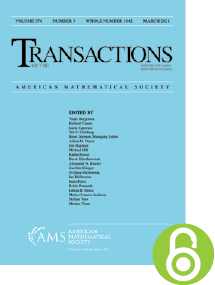Algebraic approximations to linear combinations of powers: An extension of results by Mahler and Corvaja–Zannier
HTML articles powered by AMS MathViewer
- by Avinash Kulkarni, Niki Myrto Mavraki and Khoa D. Nguyen PDF
- Trans. Amer. Math. Soc. 371 (2019), 3787-3804 Request permission
Abstract:
For every complex number $x$, let $\Vert x\Vert _{\mathbb {Z}}:=\min \{|x-m|:\ m\in \mathbb {Z}\}$. Let $K$ be a number field, let $k\in \mathbb {N}$, and let $\alpha _1,\ldots ,\alpha _k$ be non-zero algebraic numbers. In this paper, we completely solve the problem of the existence of $\theta \in (0,1)$ such that there are infinitely many tuples $(n,q_1,\ldots ,q_k)$ satisfying $\Vert q_1\alpha _1^n+\cdots +q_k\alpha _k^n\Vert _{\mathbb {Z}}<\theta ^n$ where $n\in \mathbb {N}$ and $q_1,\ldots ,q_k\in K^*$ have small logarithmic height compared to $n$. In the special case when $q_1,\ldots ,q_k$ have the form $q_i=qc_i$ for fixed $c_1,\ldots ,c_k$, our work yields results on algebraic approximations of $c_1\alpha _1^n+\cdots +c_k\alpha _k^n$ of the form $\frac {m}{q}$ with $m\in \mathbb {Z}$ and $q\in K^*$ (where $q$ has small logarithmic height compared to $n$). Various results on linear recurrence sequences also follow as an immediate consequence. The case where $k=1$ and $q_1$ is essentially a rational integer was obtained by Corvaja and Zannier and settled a long-standing question of Mahler. The use of the Subspace Theorem based on work of Corvaja–Zannier, together with several modifications, plays an important role in the proof of our results.References
- A. Baker and J. Coates, Fractional parts of powers of rationals, Math. Proc. Cambridge Philos. Soc. 77 (1975), 269–279. MR 360480, DOI 10.1017/S0305004100051082
- Enrico Bombieri and Walter Gubler, Heights in Diophantine geometry, New Mathematical Monographs, vol. 4, Cambridge University Press, Cambridge, 2006. MR 2216774, DOI 10.1017/CBO9780511542879
- Yann Bugeaud, Linear forms in two $m$-adic logarithms and applications to Diophantine problems, Compositio Math. 132 (2002), no. 2, 137–158. MR 1915172, DOI 10.1023/A:1015825809661
- P. Corvaja and U. Zannier, Diophantine equations with power sums and universal Hilbert sets, Indag. Math. (N.S.) 9 (1998), no. 3, 317–332. MR 1692189, DOI 10.1016/S0019-3577(98)80001-3
- Pietro Corvaja and Umberto Zannier, Finiteness of integral values for the ratio of two linear recurrences, Invent. Math. 149 (2002), no. 2, 431–451. MR 1918678, DOI 10.1007/s002220200221
- Pietro Corvaja and Umberto Zannier, Some new applications of the subspace theorem, Compositio Math. 131 (2002), no. 3, 319–340. MR 1905026, DOI 10.1023/A:1015594913393
- Pietro Corvaja and Umberto Zannier, On the rational approximations to the powers of an algebraic number: solution of two problems of Mahler and Mendès France, Acta Math. 193 (2004), no. 2, 175–191. MR 2134865, DOI 10.1007/BF02392563
- Jan-Hendrik Evertse and Hans Peter Schlickewei, A quantitative version of the absolute subspace theorem, J. Reine Angew. Math. 548 (2002), 21–127. MR 1915209, DOI 10.1515/crll.2002.060
- Jan-Hendrik Evertse, On sums of $S$-units and linear recurrences, Compositio Math. 53 (1984), no. 2, 225–244. MR 766298
- K. Mahler, On the fractional parts of the powers of a rational number. II, Mathematika 4 (1957), 122–124. MR 93509, DOI 10.1112/S0025579300001170
- Wolfgang M. Schmidt, Norm form equations, Ann. of Math. (2) 96 (1972), 526–551. MR 314761, DOI 10.2307/1970824
Additional Information
- Avinash Kulkarni
- Affiliation: Department of Mathematics, Simon Fraser University, Burnaby, British Columbia V5A 1S6, Canada
- Email: akulkarn@sfu.ca
- Niki Myrto Mavraki
- Affiliation: Department of Mathematics, University of British Columbia, Vancouver, British Columbia V6T 1Z2, Canada
- Address at time of publication: Department of Mathematics, Northwestern University, Evanston, Illinois 60208
- MR Author ID: 1050391
- Email: myrtomav@northwestern.edu
- Khoa D. Nguyen
- Affiliation: Department of Mathematics, University of British Columbia — and — Pacific Institute for The Mathematical Sciences, Vancouver, British Columbia V6T 1Z2, Canada
- Address at time of publication: Department of Mathematics and Statistics, University of Calgary, Calgary, Alberta T2N 1N4, Canada
- MR Author ID: 886774
- Email: dangkhoa.nguyen@ucalgary.ca
- Received by editor(s): February 25, 2017
- Received by editor(s) in revised form: May 24, 2017, and June 20, 2017
- Published electronically: November 16, 2018
- Additional Notes: The first author was partially supported by NSERC
The third author was partially supported by a UBC-PIMS fellowship - © Copyright 2018 American Mathematical Society
- Journal: Trans. Amer. Math. Soc. 371 (2019), 3787-3804
- MSC (2010): Primary 11J68, 11J87; Secondary 11B37, 11R06
- DOI: https://doi.org/10.1090/tran/7316
- MathSciNet review: 3917208


